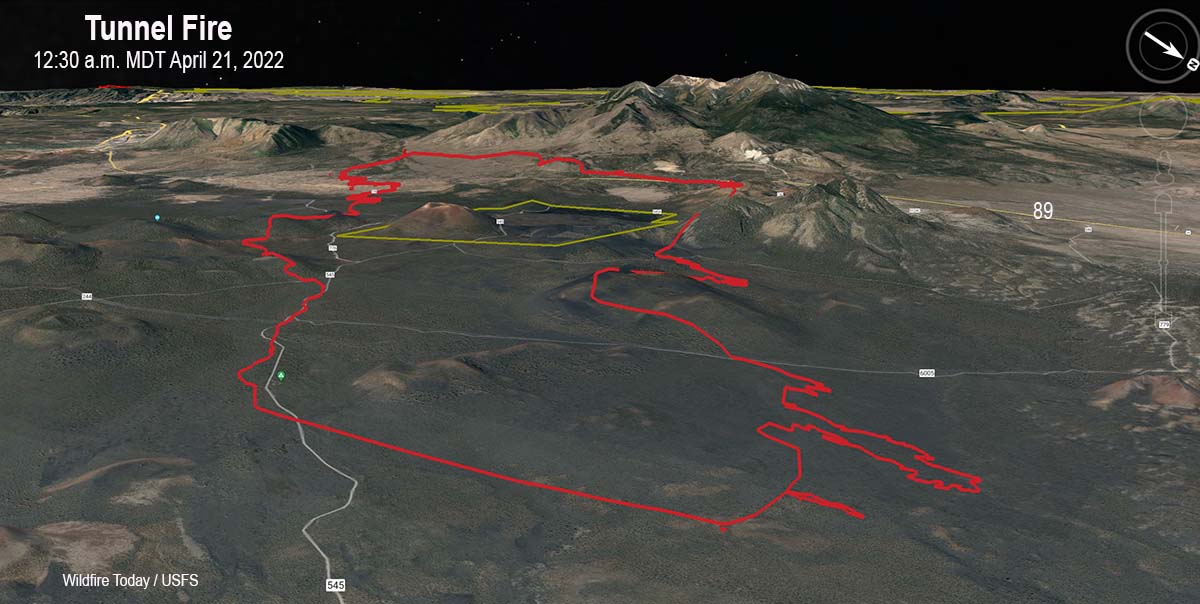Updated 10:46 a.m. MDT April 21, 2022
From the staff at Sunset Crater Volcano National Monument, which was overrun by the Tunnel Fire.
“April 20
“All Sunset Crater Volcano and Wupatki staff are accounted for and safe. We were also able to successfully evacuate all culturally important items from the visitor center. For those who worried, the Kabotie painting, corn rock, Qa’na Katsina doll, and other items are safe.
“As of 4:45 this morning, the visitor center remains unharmed, as well. However, active fires continue to burn nearby. Sadly, Sunset Crater Volcano National Monument has burned in its entirety. The park is closed, and we do not have any estimated timeline for reopening.”

In the map below, the Monument is inside the yellow border.
7:57 a.m. MDT April 21, 2022

The Tunnel Fire five miles north of the Flagstaff suburbs grew by about 3,000 acres Wednesday to bring the size up to more than 20,500 acres.
To see all articles on Wildfire Today about the Tunnel Fire, including the most recent, click here.
The fire started during the afternoon of April 17 west of Highway 89. Pushed by strong winds it spread rapidly to the northeast, crossed the highway, burned through Sunset Crater Volcano National Monument, crossed major electrical transmission lines, and early Thursday morning was about 10 miles east of Highway 89 approximately two miles from burning out of the Coconino National Forest.

On Wednesday crews worked to keep the fire out of the Timberline Estates and Wupatki Trail subdivisions. They encountered natural gas leaking from foundations of burned structures, which slowed suppression activities. On Tuesday fire officials said 24 structures had burned. The number was not broken down by residences or outbuildings.
Strong winds on Wednesday again limited the ability of aircraft to safely and effectively support firefighters on the ground. Conditions are expected to become windier Thursday and Friday. A Red Flag Warning is in effect Thursday until 8 p.m. MST due to predicted gusts of 40 to 50 mph and 10 to 15 percent relative humidity.

A National Type 1 Incident Management Team was ordered Tuesday. The 76 personnel with the team will begin arriving Thursday, with plans to assume command from the Type 3 IMT Friday morning.
Firefighting resources on scene include three dozers, 24 fire engines, and one Type 3 helicopter, for a total of 260 personnel.
U.S. Highway 89 is still closed from milepost 425 (Campbell Road) to milepost 445 and will likely remain closed for the next several days due to firefighting operations.
Information about evacuations, structures that have burned, and when people might be able to return is handled by Coconino County, which is posting updates online.


Can’t let it look like they’re burning Indian Land…now that would look pretty bad….been happening too much since 2016…calling many native lands, federal….
Smoke screen…
The area the fire started burning not long after it crossed hwy 89 is rather unusual. It’s extremely low productivity cinder soils that are sparsely vegetated. It’s always amazed me that a ponderosa seedling could survive in this area and become a tree. Because of this, the area supports some of the most interesting growth forms of ponderosa I have ever seen. I don’t typically think of this area being able to sustain a fire and expected it to peter out when it hit the Sunset Crater area and beyond. I see now that extremely windy conditions are enough to blow embers between the scattered pockets of fuels that are separated by unvegetated cinder soils. It will be interesting to see the fire effects in this area.
I thought the same thing Ben. We call much of that area the Cinder Lakes since there are wide areas of nothing but black cinders. With the wind what it was I can see embers blowing from one grassy area to another in no time. Now it seems heading up into the 40’s, areas of parceled land and then maybe past it to the Navajo reservation land. We can only hope for a few days of calm wind so this thing can burn itself out. Fingers crossed.
Out in the cinder lakes, fire would creep around in tree roots and little pockets of duff for days-it was a really interesting place to fight fire.
Does anyone know if the fire has spread into Alpine Ranches at the end of Sunset Crater Road – near the Navajo Reservation? My daughter’s house is 5 miles off that road on a washboard dirt road.
Not certain if it went that far north, it looks like it went right through Sunset Crater and was heading more Easterly. Check the link above the the last picture that says “posting updates online”. That is the County website and on it there is another link to a 36o camera site that you can watch in real time. I am glad to see many houses and ranches that were right in the fire path that were spared. I hope your Daughter’s house was one.
https://fts360overwatch.com/event/77/6326
It just goes to show, under the right conditions in our modern climate, anything and everything can burn fast. Embers find anything organic. How many times since the Yellowstone fires of 1988 have experienced firefighters said “I never saw anything like that before?”
It looks like where there is PIPO low canopy heights are another contributing factor to spread? Fire exclusion across much of that area, both in and out of the recent cinder cones, results in stands where height to live limbs is very low, creating an illusion of more dense conditions and easier spread into crowns when green fuel moisture is especially low.
Some of the most lush stands of Pine and oak the Mogollon Plateau are on older cinder cones at higher elevations. I lived below the one at Happy Jack for seven years. Those cinders are very productive soils over time.